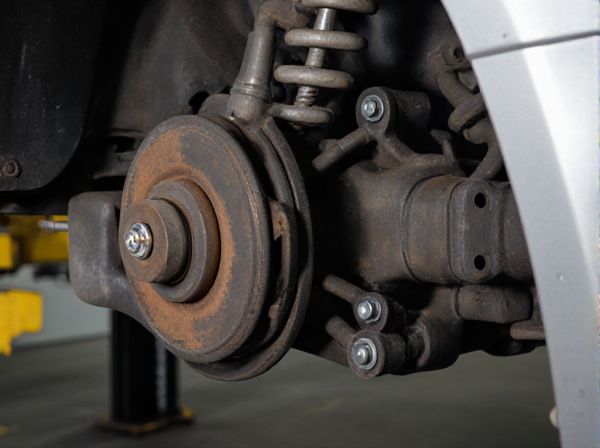
Photo illustration: Steer-by-Wire vs Conventional Linkage
Steer-by-wire technology replaces mechanical linkages with electronic controls, offering enhanced precision and reduced maintenance compared to conventional steering systems. Your vehicle benefits from faster response times and customizable steering feedback, improving overall driving comfort and safety. This advanced system also allows for greater design flexibility, as it eliminates the need for physical steering shafts and linkages.
Table of Comparison
| Feature | Steer-by-Wire | Conventional Linkage |
|---|---|---|
| Steering Mechanism | Electronic signal control | Mechanical connection via steering column |
| Response Time | Instantaneous, highly responsive | Mechanical delay possible |
| System Complexity | High, requires sensors and actuators | Low, simple mechanical parts |
| Safety | Redundant electronic fail-safes needed | Direct mechanical feedback |
| Steering Feel | Programmable, customizable feedback | Natural mechanical feedback |
| Weight | Reduced, fewer mechanical components | Heavier due to linkage parts |
| Maintenance | Software updates, sensor calibration | Physical wear and lubrication required |
| Cost | Higher initial cost | Lower initial cost |
| Design Flexibility | High, no mechanical constraints | Limited by physical components |
| Use Cases | Advanced vehicles, autonomous driving | Conventional vehicles |
Introduction to Steer-by-Wire and Conventional Linkage
Steer-by-Wire systems replace traditional mechanical linkages with electronic controls, enhancing precision and reducing vehicle weight. Conventional linkage involves direct mechanical connections through steering columns and shafts, providing tactile feedback and reliability. The shift to Steer-by-Wire technology allows integration with advanced driver-assistance systems, offering improved responsiveness and customization.
How Steer-by-Wire Technology Works
Steer-by-wire technology eliminates the mechanical linkage between the steering wheel and the wheels, using electronic controls and sensors to transmit driver inputs to the steering actuators. This system relies on torque sensors, electric motors, and microprocessors to interpret steering commands and adjust wheel angles precisely, enhancing responsiveness and reducing mechanical complexity. Compared to conventional linkage systems, steer-by-wire offers improved safety features such as variable steering ratios and automated corrections, enabling smoother and more adaptive handling.
Mechanics of Conventional Steering Linkage
Conventional steering linkage relies on mechanical connections such as tie rods, steering shafts, and rack-and-pinion gears to transmit driver input directly to the wheels, ensuring tactile feedback and precise control. These components work together through physical displacement and torque transfer, allowing the driver to feel road conditions and maintain steering responsiveness. Despite its reliability, this mechanical system is susceptible to wear and requires regular maintenance to prevent play and ensure steering accuracy.
Key Differences Between Steer-by-Wire and Traditional Steering
Steer-by-Wire systems replace mechanical linkages with electronic controls, enhancing precision and reducing weight compared to conventional steering that relies on physical connections like steering columns and linkages. Traditional steering provides direct tactile feedback through mechanical components, whereas Steer-by-Wire uses sensors and actuators to simulate road feel, allowing customizable steering response and improved safety features. Energy efficiency is higher in Steer-by-Wire systems due to the elimination of friction and mechanical losses associated with conventional linkage mechanisms.
Performance and Handling Comparison
Steer-by-Wire systems deliver precise and responsive steering inputs by electronically controlling the connection between the steering wheel and wheels, eliminating mechanical linkages and reducing lag. Conventional linkage relies on physical components such as tie rods and mechanical linkages, which can introduce play and reduce steering accuracy under high-performance conditions. Steer-by-Wire enhances handling through adaptive feedback and customizable steering ratios, providing superior control and agility compared to the fixed mechanical response of conventional steering systems.
Safety Considerations and Redundancies
Steer-by-wire systems eliminate mechanical linkages, relying on electronic controls that enable multiple redundant sensors, actuators, and backup power supplies to enhance safety and fault tolerance. Conventional linkage systems provide direct mechanical feedback and physical connection, inherently limiting failure modes but vulnerable to wear, corrosion, and mechanical binding. Safety considerations in steer-by-wire emphasize fail-safe designs, real-time diagnostics, and redundant communication channels to ensure safe handling under electronic or sensor failure conditions.
Maintenance and Reliability Factors
Steer-by-wire systems eliminate mechanical linkages, reducing wear and tear and lowering maintenance frequency compared to conventional linkage systems that require regular inspection and lubrication of physical components. The absence of hydraulic fluids and mechanical joints in steer-by-wire enhances reliability by minimizing potential failure points and improving response consistency. Conventional linkages are prone to mechanical fatigue and environmental damage, increasing downtime and repair costs, while steer-by-wire leverages electronic controls and sensors to provide diagnostic feedback, facilitating predictive maintenance.
Cost Implications and Market Adoption
Steer-by-wire systems eliminate mechanical linkages, reducing manufacturing and maintenance costs through fewer components and enhanced design flexibility. Conventional linkage steering requires extensive hardware and regular maintenance, resulting in higher long-term expenses and limited adaptability for advanced driver-assistance systems. Market adoption of steer-by-wire is accelerating in electric and autonomous vehicles due to cost efficiency and integration advantages, while traditional linkage remains prevalent in standard vehicles because of established infrastructure and reliability perceptions.
Future Trends in Automotive Steering Systems
Steer-by-wire technology eliminates mechanical linkages between the steering wheel and wheels, enabling precise electronic control and enhanced customization in automotive steering systems. Future trends emphasize integration with autonomous driving capabilities, advanced driver-assistance systems (ADAS), and increased safety through real-time feedback and adaptive responses. Conventional linkage systems are gradually being replaced due to their mechanical limitations and reduced flexibility in implementing next-generation steering innovations.
Choosing the Right Steering System: Pros and Cons
Steer-by-wire systems eliminate mechanical linkages, offering precise control, reduced weight, and enhanced design flexibility but may face challenges in reliability and require fail-safe redundancies. Conventional linkage steering provides direct tactile feedback, proven durability, and simpler maintenance, though it adds mechanical complexity and weight. Choosing the right steering system depends on balancing advanced technology benefits against reliability and user experience priorities.
 caratoz.com
caratoz.com